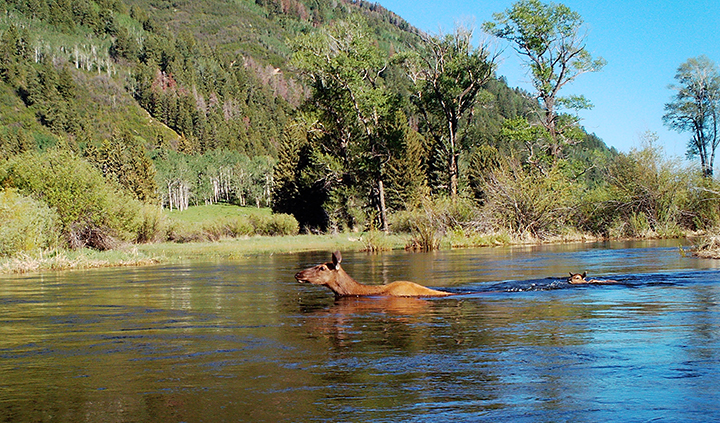Keeping tabs on North Star's wildlife

An elk and her calf make their way across the river at North Star Nature Preserve.
Recreational use of North Star Nature Preserve often captures the spotlight, but its habitat and wildlife are a continuing focus for Pitkin County Open Space and Trails, which manages the 245-acre preserve with the goal of protecting and enhancing the property’s ecological functions.
To that end, the flora and fauna at North Star are monitored every three to five years. Bird monitoring was conducted in 2020 and 2021 as part of a system-wide effort, while wildlife surveys were conducted in 2021. The data from both was analyzed for a 2024 report prepared by Colorado Wildlife Science. This latest information will help guide management of the preserve as Open Space and Trails updates its management plan for North Star in 2025.
A few takeaways from the report:
• Overall detections of deer and elk at North Star were higher than in previous survey efforts, though the increase may reflect variable environmental conditions such as snowpack depth, flooding or plant conditions. In addition, elk use of North Star was documented during the critical reproduction season (May/June).
• Moose, coyote and northern pocket gopher detections were also up compared to years past, while black bear detections were lower. These were all point-in-time observations, influenced by year-to-year variability in environmental conditions (snowpack, flooding, drought, forage conditions elsewhere, etc.), but continued monitoring over time will help reveal the trends on-site.
• During a 24-hour period, there were two distinct peaks of wildlife activity: 5-8 a.m., and 4-11 p.m.
• Fifty-two different bird species were detected at North Star in 2020. Of those, 32 are considered species of conservation concern by at least one agency. The preserve’s avian species diversity score of 3.49 in 2020 was the highest ever at the property. (It is rare to get a score above 3.5 using the Shannon Diversity Index.)
• There is a high ratio of sensitive bird species to human-tolerant species, meaning the property is meeting the needs of many bird species that are sensitive to human activity.
• Some shifts in habitat use by wildlife are being observed, most notably a decrease in detections within the grassland habitat type. Looking at deer and elk alone, in 2021 there seemed to be a shift away from use of willow shrublands by deer, and a shift away from grasslands by elk. Both species were detected in the aspen woodlands much more frequently than in previous years. Of note: the detection data was heavily influenced by northern pocket gophers (a native species), which may be shifting habitat use in response to the restoration of a wetland at North Star and the resulting increased saturation of the grasslands. This is a correlation, not causation, but interesting nonetheless!
• Red-wing blackbirds are the only Management Indicator Species at North Star on the decline. This is a human-tolerant species that relies on emergent wetlands, but is on the decline nationally. They are among nine indicator species at North Star, selected as representative of the preserve’s overall wildlife. The theory is, if the indicator species are doing well, other species that use the same habitat types are, as well.
• Great blue herons, another Management Indicator Species, have not been seen nesting within the preserve since 2018, but are known to be successfully nesting upstream of the Open Space, below the Wildwood put-in. Herons are frequent visitors to forage within the preserve along the river and in the backwater areas.
• Other designated Management Indicator Species are stable or increasing in density within the preserve. Among them are beavers, which appeared to be increasing in number when they were specifically studied in 2018. An increase in beaver-influenced areas have paralleled improved health of the riparian ecological system at North Star, according to the 2024 wildlife report.
Among the report’s recommendations are the conducting of wildlife studies at no more than three-year intervals and bird studies every other year; steps to protect herons if they re-establish nest sites in the preserve; protecting side channels where beavers are active; studying the cause of red-winged blackbird declines at the preserve; continuing management actions such as the closure of the preserve’s west side to the general public and the prohibition on dogs at the preserve; and developing a policy to related to wolves, which have been reintroduced to Colorado.
This report provides valuable scientific information about wildlife activity at the preserve, but it represents just one of many things that Open Space and Trails undertakes to care for and enhance North Star Nature Preserve. Vegetation monitoring, water-quality and aquatic-life monitoring, groundwater monitoring, and soil-moisture monitoring also occur at regular intervals to help paint the full ecological picture of North Star. Additionally, habitat enhancement efforts that often fly under the radar occur on an annual basis as part of OST’s adaptive management strategy, including willow planting, native seeding, tree regeneration protection and noxious-weed control. Collectively, OST staff spends hundreds of hours annually on the preserve undertaking these stewardship activities.
– By Pitkin County Open Space and Trails
KEY LINKS
North Star Nature Preserve Wildlife Monitoring Report (2020-2021 Field Seasons)
North Star Nature Preserve Quantitative Vegetation Monitoring (2023)
